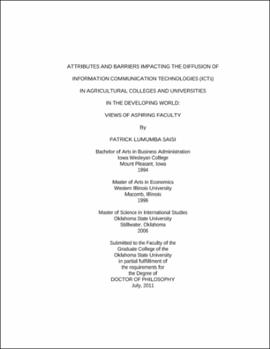| dc.contributor.advisor | Edwards, Craig | |
| dc.contributor.author | Saisi, Patrick Lumumba | |
| dc.date.accessioned | 2013-11-26T08:22:22Z | |
| dc.date.available | 2013-11-26T08:22:22Z | |
| dc.date.issued | 2011-07 | |
| dc.identifier.uri | https://hdl.handle.net/11244/6572 | |
| dc.description.abstract | Scope and Method of Study: The sample for this descriptive-correlational study included 72 international graduate students from developing countries who were enrolled in the College of Agricultural Sciences and Natural Resources (CASNR) at Oklahoma State University in the Fall semester of 2010. The study assessed the perceptions of the participants on the attributes and barriers impacting the diffusion of information communications technologies (ICTs) to advance agricultural education in colleges and universities in developing countries. The study also described the relationships between selected personal and professional characteristics of the study's participants and their perceptions on variables impacting the diffusion of ICTs. A survey instrument was used to collect data. | |
| dc.description.abstract | Findings and Conclusions: A majority of the study's participants were males who averaged 30 years of age and 3.43 years of professional experience. Many of the respondents were from Asia and about one-half of them anticipated working in tertiary institutions in their home countries after graduation. Per Rogers' (2003) �stages of the innovation-decision process� (p. 138), as a group, the participants perceived their levels of innovativeness regarding the use of ICTs in academic learning to be between �unpersuaded� and �persuaded.� The participants' views overall on the attributes associated with impacting the diffusion of ICTs in colleges and universities in developing countries were in the range of �agree.� Although the respondents �agreed� that the attributes measured had the ability to advance the diffusion of ICTs, their views on two of the five attribute constructs (i.e., trialability and observability) were �neutral.� The participants' perceptions overall regarding nine barrier constructs were in the range of �moderate.� However, the participants perceived three barrier constructs (i.e., �financial concerns,� �lack of technical expertise,� and �lack of infrastructure�) to be �strong barriers� individually. Excluding a few positive relationships that were not statistically significant, as participants' perceptions of agreement with the five attributes most frequently associated with the diffusion of innovations (i.e., per Rogers, 2003) increased, their ratings for the strength of barriers regarding the use of ICTs decreased. | |
| dc.format | application/pdf | |
| dc.language | en_US | |
| dc.rights | Copyright is held by the author who has granted the Oklahoma State University Library the non-exclusive right to share this material in its institutional repository. Contact Digital Library Services at lib-dls@okstate.edu or 405-744-9161 for the permission policy on the use, reproduction or distribution of this material. | |
| dc.title | Attributes and barriers impacting the diffusion of information communication technologies (ICTs) in agricultural colleges and universities in the developing world: Views of aspiring faculty | |
| dc.contributor.committeeMember | Cartmell, Dwayne | |
| dc.contributor.committeeMember | Blackwell, Cindy | |
| dc.contributor.committeeMember | Vitale, Jeffrey | |
| osu.filename | Saisi_okstate_0664D_11517.pdf | |
| osu.accesstype | Open Access | |
| dc.type.genre | Dissertation | |
| dc.type.material | Text | |
| dc.subject.keywords | agriculture | |
| dc.subject.keywords | diffusion of innovations | |
| dc.subject.keywords | distance education | |
| dc.subject.keywords | education | |
| dc.subject.keywords | information communication technology | |
| thesis.degree.discipline | Agricultural Education | |
| thesis.degree.grantor | Oklahoma State University | |
